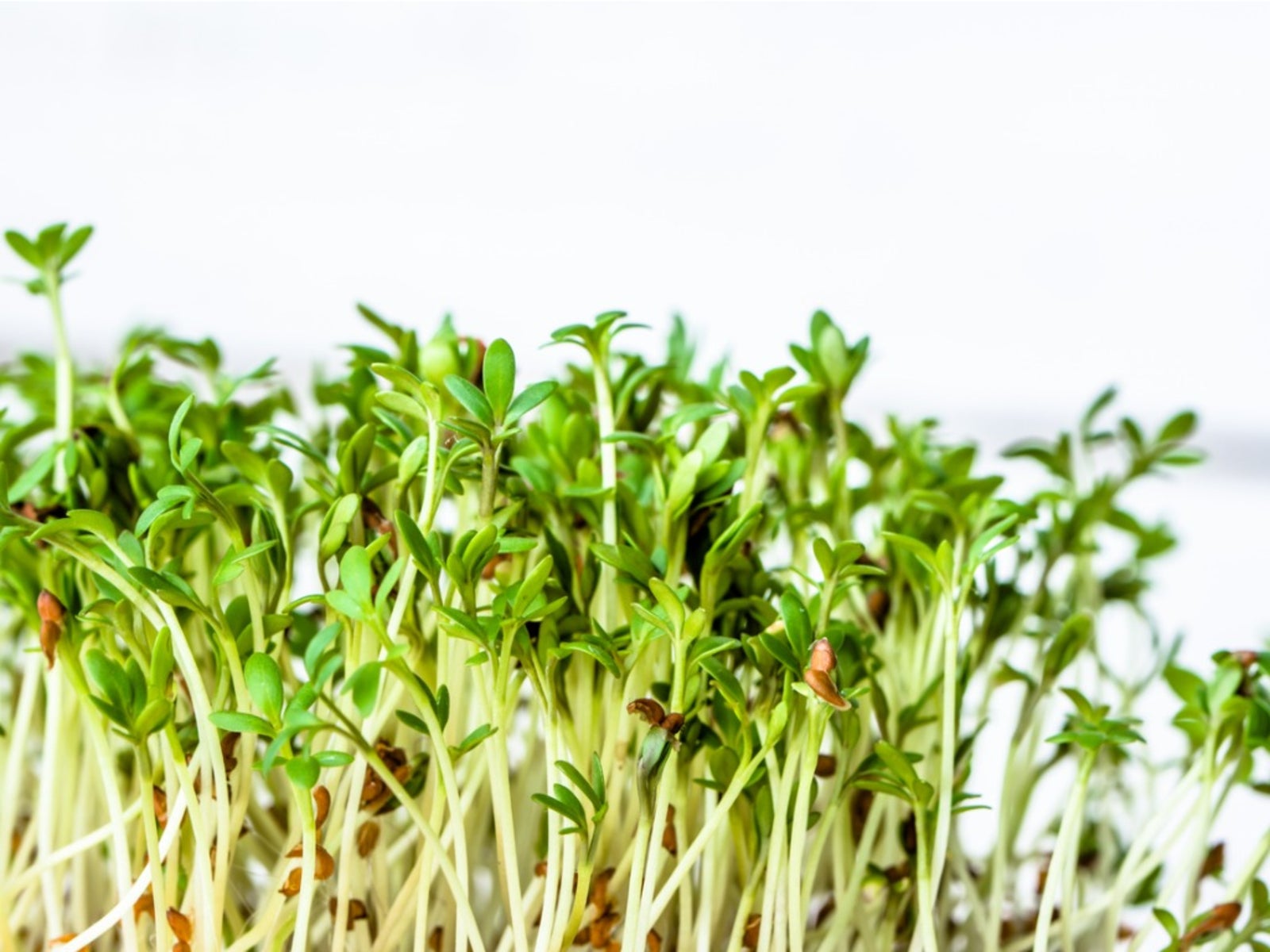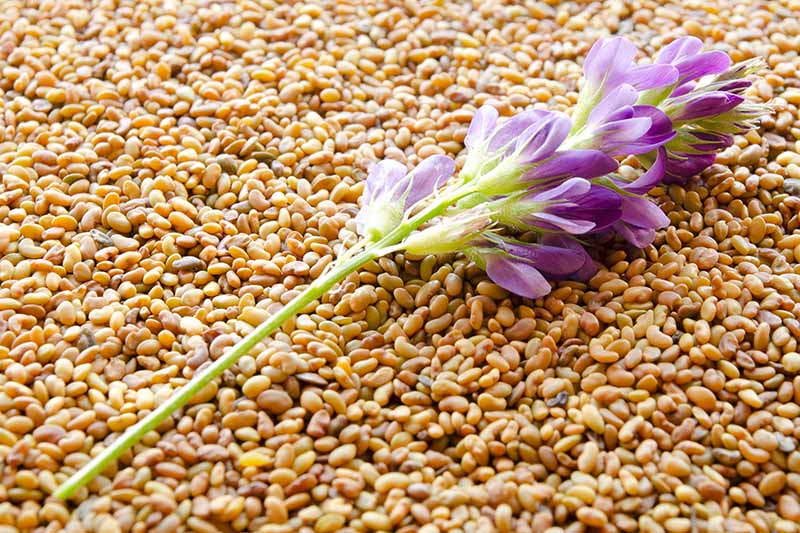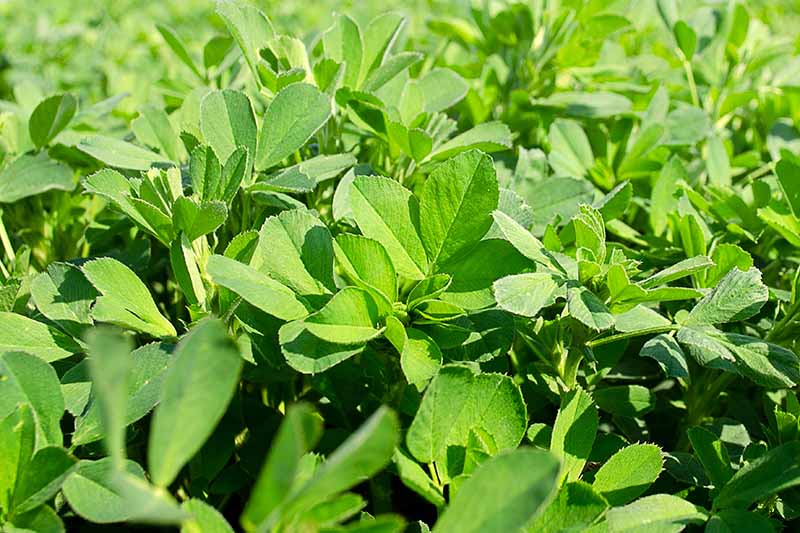If you mainly associate alfalfa with pellets for rabbits and guinea pigs, you’re in for a wonderful home gardening surprise.
Along with being a food crop for livestock and pets, this plant shines as an easy-care, affordable cover crop, especially when planted in the fall.
It will improve the soil, suppress weeds, and control erosion from winter rains. Grown as an annual or perennial, it’s also a good source of mulch, and a prime addition to the compost pile.
We link to vendors to help you find relevant products. If you buy from one of our links, we may earn a commission.
I’d like to help you start growing this helpful legume in a way that assists you with your own garden needs, while steering clear of rookie mistakes made all too easily when you grow alfalfa for the first time.
It is pretty, producing little bunches of small, brilliant blue flowers on the upper portions of its side stems.
Strictly speaking, it is a perennial. Farmers grow stands that perpetuate for many years, and they cut successive crops to dry and bale to feed farm animals, much like wheat.
For the home gardener, it’s simplest to grow it as an annual cover crop or “green manure,” and till it under at the end of the season to enrich depleted soil.
These plants have taproots that can grow down six feet or more. Once it’s established, each plant develops a “crown” where it emerges out of the soil.
The crowns form bud shoots, which allow gardeners to harvest all but the bottom two inches of the plants and have them send up new stalks from the axillary buds.
If you live in an area where untreated mulch for vegetable gardens is hard to come by, you may also want to devote an area of your garden or yard to growing some to harvest as mulch, or to add to compost.
You can do that most easily by sowing and cutting a “stand” of alfalfa each fall, treating it as an annual.
It’s more involved, but also possible to plant alfalfa as a perennial source of mulch and compost, or to cut some for those purposes and then work the rest into the soil.
Growing a healthy alfalfa plant outdoors can seem intimidating for beginner gardeners. But with the right techniques materials and a little patience you can cultivate a thriving alfalfa patch in your backyard. This versatile plant has many uses – from nutritious animal feed to nitrogen-fixing cover crop. Follow this guide to get your alfalfa patch off to the best start.
Choosing the Right Location
-
Full sun exposure is crucial, so pick a sunny spot in your yard. At least 6 hours of direct sunlight per day.
-
Well-draining soil is ideal. Alfalfa thrives in loamy soil and struggles in heavy clay. Improve drainage by mixing in compost.
-
Avoid windy areas that will dry out the soil too quickly. Some shelter from harsh winds is best.
-
Check the pH. Alfalfa grows best in slightly alkaline soil with a pH between 6.5-7.5. Adjust as needed.
-
Rotate planting sites each year to prevent disease. Don’t plant alfalfa where tomatoes, peppers, potatoes grew recently.
Timing Your Planting
-
Spring planting can be challenging due to weed pressure. Better to plant in mid to late summer.
-
Wait at least 6-8 weeks before the first fall frost to plant seeds or seedlings. This gives them time to establish.
-
In very cold climates, plant in spring as soon as soil can be worked. Avoid fall planting if winters are harsh.
-
Stagger planting over 2-3 weeks for a continuous harvest. Smaller, successive plantings are easier to manage.
Preparing the Soil
-
Loosen soil to a depth of 12 inches and remove any rocks or debris. Alfalfa has a deep taproot.
-
Mix in 2-3 inches of aged compost or manure to enrich the soil with nutrients. Rake smooth.
-
Just before planting, treat seeds with an inoculant to boost nitrogen fixation. Follow package directions.
-
For transplants, treat roots with inoculant. Or use pre-inoculated seedlings from nursery.
Planting Methods
Seeds
-
Direct sow seeds 1/4-1/2 inch deep in prepared soil. Space 2 inches apart in rows 12-18 inches apart.
-
Expect germination in 5-7 days. Thin seedlings to final spacing of 6 inches once established.
-
Keep soil moist, not soaked, until seedlings appear. Water gently to avoid washing seeds away.
Transplants
-
Start seeds indoors 6-8 weeks before transplanting out. Harden off before planting.
-
Carefully dig holes and place young plants 6 inches apart in rows 12-18 inches apart.
-
Water transplants daily for the first week or until they show new growth. Keep soil moist, not wet.
Caring for Your Alfalfa
-
Weed regularly when plants are young and vulnerable to competition. Avoid weeding once established.
-
Water 1 inch per week if rainfall is insufficient, more in very hot/dry weather. Avoid overhead watering.
-
Apply mulch around base of plants to retain moisture and suppress weeds. Leave space near stems.
-
Cut plants back to 2 inches when blooming begins. This stimulates regrowth for additional cuttings.
-
Loosen soil gently with a fork in fall and apply compost. Test soil pH annually and adjust as needed.
-
Allow plants to go dormant in winter. Resume watering when they show new growth in spring.
Dealing With Pests and Disease
Common alfalfa pests:
-
Aphids – Treat with insecticidal soap or neem oil spray
-
Weevils – Pick off adults, trap larvae by spreading flat boards on soil
-
Voles – Use wire mesh fencing dug 10 inches into soil to deter
Diseases to watch for:
-
Anthracnose – Improve air circulation. Use resistant varieties.
-
Phytophthora Root Rot – Allow soil to dry between waterings
-
Downy Mildew – Avoid overhead watering and crowding plants
-
Leaf Spot – Pick off infected leaves. Space plants properly.
When and How to Harvest
-
Cut established plants when buds appear but before flowering for best feed quality.
-
Use gardening shears or sickle, cutting stems 2 inches above crowns. Remove any dead stems.
-
Allow plants to regrow before next cutting, about 6-8 weeks. Three cuttings per season is typical.
-
For compost/mulch, cut when half the plants are in bloom. Dry cuttings before use.
-
To use as green manure, cut and till plants into soil before seed pods form.
With proper site selection, soil preparation, planting, and care, your alfalfa patch can thrive! Pay close attention in the early stages as young plants establish. But once mature, alfalfa is quite hardy and productive. This nourishing crop will reward you with an abundant harvest year after year.

Where to Find Seeds
All set to grow your own alfalfa?
If you’re planning to plant M. sativa as a cover crop, it’s a good idea to check with your local ag extension agent to find out if there are any particular pests or diseases that threaten the green manure in your growing area.

If so, they may be able to recommend a variety that grows well in any adverse conditions common to your location.
‘Allstar,’ for example, was bred to be resistant to Anthracnose, bacterial and Fusarium wilts, and Phytophthora root rot.
This cultivar is available from True Leaf Market already inoculated with rhizobium bacteria that encourage the seedlings to fix nitrogen in the soil.
You can find one-ounce packets for small areas, and one- and five-pound sacks for larger areas.
If you buy seeds from a local farmer’s co-op or similar entity, they will probably be inoculated and coated with a fungicide like Apron. That’s something to be aware of if you’re committed to organic growing.
And while that coated seed can work for a cover crop or growing animal feed if you aren’t worried about the chemicals, please remember that inoculated or coated seed is not suitable for growing sprouts that you plan to eat.
You can find M. sativa seeds for sprouting in four-gram and four-ounce packets, and one-, five-, and 25-pound bags, from True Leaf Market.
An organic option is available as well, in a variety of packet sizes.
For fungicide-free seeds you can also grow as sprouts or microgreens, Botanical Interests offers 30-gram packs. That’s close to 13,000 seeds. Just make sure you inoculate them yourself if you’re growing them as green manure.
Harvesting for Mulch or Compost
When you’ve seeded this legume as a cover crop, for mulch, or to add to compost, it’s essential to either pick or till the plants before they go to seed.

To use it as “green manure,” work the entire plant, blooms and all, into the garden plot at least a few weeks – or preferably a whole season – before planting veggies in the restored, amended soil.
Here’s the best method:
Once about half of the plot has bloomed, and before it starts forming seed pods, cut it to about two inches tall with a scythe, clippers, or an electric mower.
Then till the plants and mown stalks back into the soil until they are four to 10 inches below the surface, and leave them to decompose.
You can spread the clippings on a clean tarp or blanket and dry them in the sun for a few days before using them to mulch around the yard and garden.
A word of caution, though. When you mulch with dried alfalfa, you run the risk of attracting the many herbivores that like to eat it, which include pests like rats, rabbits, and deer.
You can also add the clippings to your compost, where their high nitrogen content will make them break down quickly and also accelerate decomposition for the rest of the plant material that’s in there.
Learn more about what to compost and how to use it to benefit multiple aspects of your home garden in our beginner’s guide.
If you’re growing a perennial stand for compost or mulch, you should skip the step where you till the stalks into the soil.
Instead, keep the plot watered and weeded, and you may have another “crop” of stalks to dry for mulch or to add to compost within 40 to 45 days.
You can’t necessarily go by the calendar on this one though, since temperature, available rain, and the health and age of the plants can all impact the amount of time it takes them to regrow and bloom.
Be sure to observe the plot occasionally, since any harvest always needs to be done ahead of seeds forming.
The seeds will grow in your compost or around any areas where you mulch, as well as creating a new bed of alfalfa in the area where you were using them as a cover crop.
Growing Alfalfa for the Backyard Grower
FAQ
Does alfalfa come back every year?
What is the best month to plant alfalfa?
Is alfalfa easy to grow?
How long does alfalfa take to establish?
How do you grow alfalfa?
When growing alfalfa, choose an area with plenty of full sun. Also look for a well-draining area with a soil pH level between 6.8 and 7.5. Prior to planting you should clean the area, work the soil, and remove any debris. Pure alfalfa seed can be purchased from most feed supply stores.
Can alfalfa grow outside?
If you’re growing alfalfa outside, such as for animal feed, hay, etc., then it can be a bit picky about soil. It doesn’t do well in clay-dense, wet, heavy soil. Instead, aim for well-draining, compost-rich soil with a pH between 6.5 and 7.5. If your pH is below 6, it may fail to thrive.
What should I know before planting alfalfa?
Before you begin the process of planting alfalfa, there are some things you should know. The first is that the success of your crops depends on the soil. The best soil to plant alfalfa in is well-drained soil located on level ground.
What soil should alfalfa grow in?
Although alfalfa soil requirements are not too strict, the plant grows best in deep, well-drained, loamy soil. Soil pH for alfalfa should be between 6.5 and 7.0, as this allows for symbiotic nitrogen fixation. By adding lime, you can bring the acidic soil’s pH up to a desirable level.
